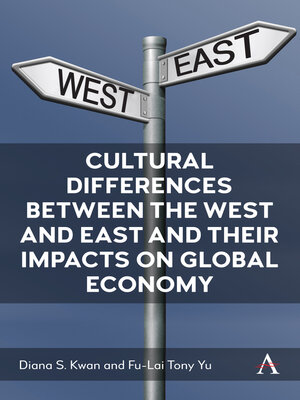Cultural Differences between the West and East and their Impacts on Global Economy
ebook
By Diana S. Kwan

Sign up to save your library
With an OverDrive account, you can save your favorite libraries for at-a-glance information about availability. Find out more about OverDrive accounts.
Find this title in Libby, the library reading app by OverDrive.



Search for a digital library with this title
Title found at these libraries:
| Library Name | Distance |
|---|---|
| Loading... |
This volume consists of four parts, comprising 15 chapters. It highlights the roles of culture and institutions on economic and social changes. The West is illustrated by the United States, Britain or Canada and the East, by chopstick economies such as China, Taiwan and Hong Kong. Part I is the theoretical framework. It contains five chapters. Chapter 1 (Searching for the New Paradigm: Uncertainty and Learning in the Evolutionary Approach) employs the evolutionary perspective to interpret economic and social transformations. Chapter 2 (Culture and Institutions on Economic Transformation) explains the relationship between traditional belief/ideology/religion and culture. The West adopts rule of law while the East, rule by law. In chapter 3 (Quilt and Shame Cultures: Anglosphere versus Chopstick Economies), a Christian nation in Western economies, such as the United States, is identified as a society of guilt while chopstick economies in the East, such as China, are embedded with Confucianism, a society of shame. Cultural difference has implications on social control and educational reform. In chapter 4 (Chinese Legalism and European Mercantilism), contemporary China utilises Confucianism supplemented by Legalism to strengthen the state power. Legalism is akin to European Mercantilism. Chapter 5 (An Imagined Social World in the West and East) highlights the imagined world in the West and East.
Part II presents different cases in entrepreneurship and everyday life creativity. Chapter 6 (Entrepreneurship: Transformative and Adaptive) argues that the United States, due to individualism and self-assertion, brings technological breakthroughs in the world while Asian economies such as China receive training in Confucianism, and provide the world with mainly adaptive entrepreneurs and imitative products. Culture makes a difference in entrepreneurship and hence economic transformation. Chapter 7 (Intellectual Property Protection: The Case of Smartphone) explains the origin of the disputes in U.S.–China intellectual property protection. It is illustrated by Huawei, a learner in technological transfer. Chapter 8 (The 'New Opium War': On Supplying Fentanyl) argues that China's ways of handling the production and consumption of fentanyl contrast sharply with the Western powers. Fentanyl crisis is the New Opium War! Chapter 9 (Electoral versus Authoritarian States: Combating Coronavirus Disease Pandemic) compares pandemic-associated measures in the United States and China. It reveals that culture counts in tackling global responses to infectious diseases. Chapter 10 (If Shakespeare Is the West, then Jin Yong is the East) compares the works of Shakespeare and Jin Yong. Shakespeare works focus on individualism and self-reliance while Yin Yong works stress on familism and patriotism.
Part III highlights the impacts of culture on Chinese economies. Chapter 11 (A Winning Tactic? Social Construction of Peasanty in Socialist China) explains how Mao Zedong turned Chinese peasanty, if not serfs, into a winning game for his party. Peasanty were 'oppressed' by their landlords. After painbearers cried out their suffering and killed the landlords, they could stand up again. They supported the Chinese Communist Party instead of the Nationalist Party (Kuomintang). Chapter 12 (Culture, Nationalism and Wolf Warrior Diplomacy) argues that foreign policy reflects culture and history. China's wolf warrior diplomacy traces its roots back to culture. Chapter 13 (Impacts on Taiwan: Sharing the Same Culture versus Different Social Identity) examines whether the same culture will entail different impacts on Taiwan's politics. It also explores whether different social identities affect Taiwan's...







